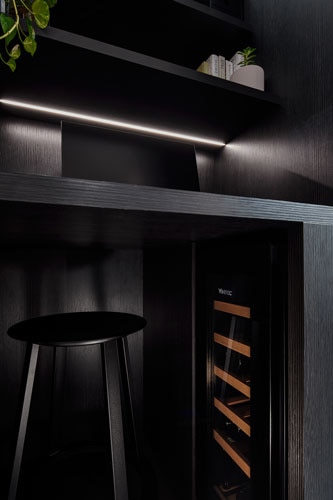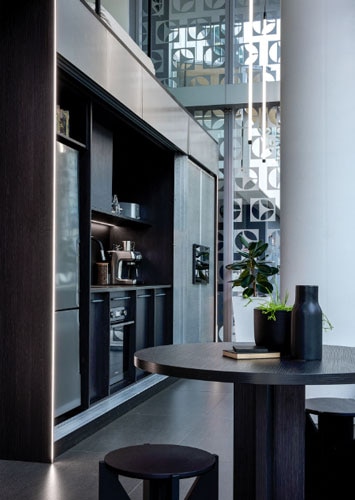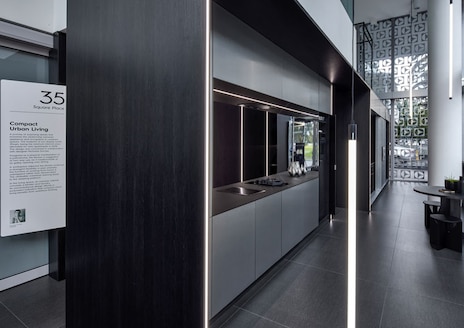
Nicholas Gurney Biography
Nicholas Gurney established his eponymous design studio in 2010 after completing a Bachelor of Industrial Design. The works of his practice are allied with the concepts of reductivism and beautility. Projects are highly functional and considered, delivering dynamic and clever solutions with a focus on the organisation of space. Through design and innovation, Nicholas aims to dispel conventional notions surrounding compact design and small-space living. Gurney employs a strong conceptual focus and the needs of his clients are heavily embedded in the outcomes, which is showcased in the Compact Urban Living Space project he collaborated with Electrolux on, at the Mascot headquarters. Read through the Q&A below on how this unique space came to be..


How have you applied your experience to be at the forefront of design in the compact urban living space in Australia?
My training is in Industrial Design. During the latter stages of my studies, I became jointly concerned with industrial design and how people dwell. I think I was ultimately destined for architecture and interior design but with an alternate grounding that could be distinguishable in my work. I’ve long held the belief that ambitious, unconventional and bespoke design in the home is within the realm of an industrial designer. My work continues to provide a purposeful indication that compact urban living benefits from this type of thinking.
What was it that appealed to you about being a part of this project?
Promoting ingenuity in tandem with a globally recognised brand was an unmissable prospect. The motivation and ambition of the team to deliver a transformative solution most appealed to me. I felt the future thinking championed by Electrolux would be paramount to the success of the project and I was excited by its positioning in the showroom and the resulting opportunity to provide an alluring visual hook. From the outset, I was confident that I could add value and successfully impart my expertise to help Electrolux achieve its goals for the installation.
Talk us through some of the design elements you have incorporated to make the compact space multipurpose?
Imagined as a physical manifestation of a palindrome, the kitchen is suggestive of two-way use, be it inside/outside or as a galley opening onto dining. The workspace adjacent to the kitchen endorses divergent flexibility in a plan whereby the function of working-from-home is overlapped rather than demarcated. The climbable overhead shelving leads to the sleeping platform and a wine fridge (yes, wine) is tucked underneath the desk. In the living space, an oversize cabinet conceals a kitchen and laundry. Both kitchens are afforded the luxury of full-size appliances and truly highlight that functionality is independent of scale, proving that good design can navigate exigent conditions.



Could you tell us how you went about selecting the materials for this job?
I sought to limit the breadth of material and avoid ubiquitous finishes. It’s always been my inclination to champion robust materials such as steel or timber before precious materials such as marble. To that end, a reductive, monochromatic palette was conceived to best nurture the perceived strength of the inherent ideas rather than resort to a grandiose aesthetic. In propounding something novel, the need for the new insertions to meld with the existing showroom experience became integral and the materials are an observable link.

What are the greatest challenges you face when designing a project like this?
For a project such as this, the greatest challenges are two-pronged. The paramount consideration is meeting the demands of the brief and in turn, sympathetically aligning with the brand and its aspirations. With a clear goal and distinctive methodology, the narrative of the project was clear at the outset. Such clear direction ensured that in the period between concept and realisation, minor alterations and enhancements could be introduced without wholesale manipulation.
Secondly, I felt a strong need to establish harmony with the existing condition. To fashion a continuity between the architectural envelope and the existing primary showroom, I sought to avoid the creation of a ‘room within a room. As such, there are no new walls, ceilings or obvious boundaries and each new element saddles an existing built element, appearing as though it was conceived as part of the wider context. Design for rapid on-site installation meant minimal disruption to business activities.
What do you think the future looks like for Compact Living in Australian capital cities?
I think compact living will progressively pervade the urban setting. In future, compact living will increasingly meet the demands of our complex social fabric and place greater emphasis on the needs of its occupants. We’re experiencing a period of hasty change and with that, a much welcomed flexibility. There is the need for reduction in every facet of our lives and there are boundless opportunities for this to be evident in the design of our living environments; both new and re-fashioned, both small and large. But we don’t need large. We need small. With an ever widening wealth disparity, scarcity of new dwellings, an affordability crisis and the clear and obvious need for densification, the solution may well be compact urban living.
To find out more information about designing for smaller kitchen and laundry spaces in multi-res dwellings, please see Electrolux Home Products WP-C-T 21863 and the infographic.
